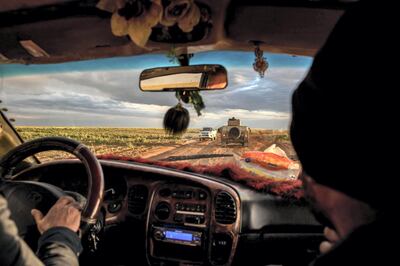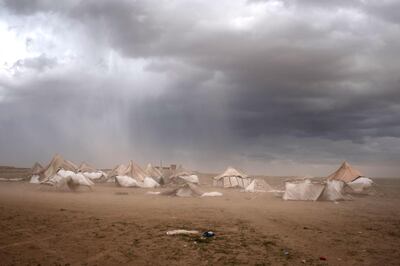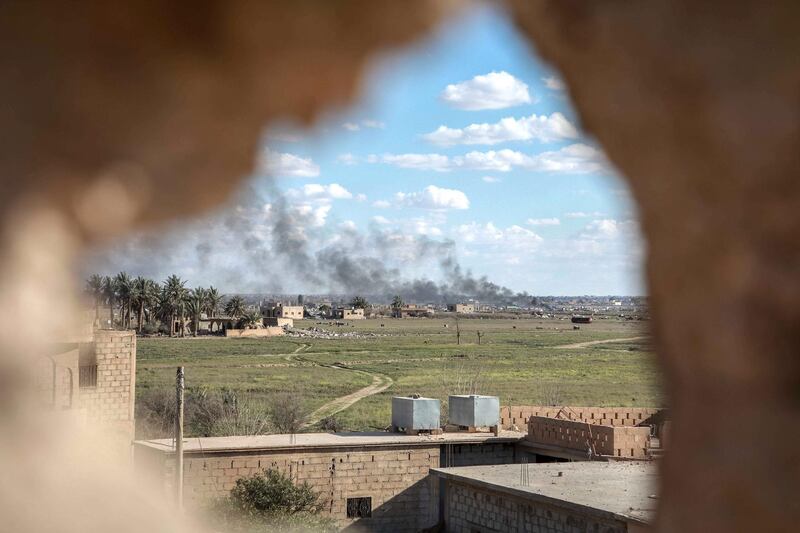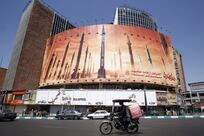The first hints that things might not go to plan came before we started driving to the eastern Syrian governorate of Deir Ezzour. We were bound for Baghouz. Situated on a bend in the Euphrates River, few had even heard of this isolated farming area until it emerged, a few months ago, as the place where ISIS would make its last stand.
Caught between Russian troops and forces loyal to the regime of Bashar Al Assad on one side of the river, and the Kurdish-led Syrian Democratic Forces on the other, this 700-square-metre area is now all that remains of a so-called caliphate that once spread across a third of Syria and Iraq.
Baghouz is a stone’s throw from the Iraqi frontier, but we began our journey nearly 500km north, near the Turkish border. We headed into Hassakeh, a northern town, where control is divided between the Syrian regime and the Kurdish-led “self-administration of north-east Syria”. From there, the road cuts through the country’s wheat-producing Khabur River valley, a fertile, populated landscape that gives way to a lonely, featureless desert.
Against that arid backdrop, ISIS members on motorcycles have recently shot up vehicles carrying military personnel. Improvised explosive devices are reportedly being laid at night. Hearing that, it became apparent that the US-backed SDF was not fully in control of the territory it had already taken. Its command instructs all media to travel in a convoy, accompanied by military vehicles. But Perwer, our Syrian-Kurdish fixer, believed this to be too dangerous. “It’s a big target, man,” he said. Better to travel incognito in a rented taxi van, of the kind often seen in the area.
With a vehicle secured, myself and Willy, the cameraman I was working with, slouched down in the back seats, roaring past villages and through checkpoints. Later, we stared through tinted windows at long stretches of empty road.

The initial pitch had been to cover the final battle against ISIS. I had written about the group since 2014, and covered the fighting throughout the nine-month battle for Mosul – Iraq’s second city and the jewel of ISIS’s caliphate. By the time the SDF captured Raqqa, ISIS’s Syrian capital in 2017, I was burned out and believed the group to be a spent force too. I had viewed Baghouz as largely symbolic – a chance to witness the end of this once-fearsome organisation. But, already, it seemed like the beginning of something else.
Reaching the SDF-held Omar oil field, we quickly joined a convoy heading towards a desert area outside Baghouz, where surrendering ISIS members and their families were being screened. That day, we watched as, according to the SDF estimates, some 2,000 people handed themselves over. Long lines of women and children were searched. The few men among them were assumed to be fighters and separated to one side.
The numbers coming out of Baghouz were mind-boggling, said the SDF’s head of media Mustafa Bali. The SDF had originally expected just a few thousand people to be holed up there.
Al Hawl camp, a squalid tent city where most of the ISIS families have been taken, was originally designed for 20,000 people. It was later expanded to cater for 40,000 and is now home to more than 67,000. “Nobody could have guessed there were so many women and children,” one aid worker told me.

Some of those women are the most deeply committed ISIS supporters, people who have stuck with the group through years of increasing bombardment, isolation and hardship. A large proportion of those we saw were foreigners – from Indonesia, Kyrgyzstan, Turkmenistan, Turkey, Morocco, Tunisia and across Europe. One woman, her face covered, wore Salomon hiking shoes and carried a Fjallraven backpack. Most refused to speak to journalists. Some were openly hostile.
The men sat in quiet rows. A young Bosnian told me that he had left Baghouz when conditions became unbearable. A kilo of sugar was selling for $50, he said, and people were surviving by eating unprocessed wheat used for animal feed. Polluted drinking water was making people sick. However, he added, until the last minute there were rumours that ISIS would negotiate a way out for its members. Surrender to the SDF began to appear less like an admission of defeat or disavowal of the group than a calculated attempt to live and, possibly, fight another day.
One woman threatened to sue a photographer for taking her photograph without permission. Although laughable, this incident was illustrative of a broader mindset. Many members of ISIS – both western and Arab – joined to escape a world that they believed had little to offer them other than oppression and lack of opportunity. “What’s happening to these people [in Baghouz] is a reflection of what’s happening to Muslims worldwide,” the Bosnian man said. In the bubble they have inhabited, it has been easy to maintain a narrative of victimhood.
People we spoke to said they had been bombed relentlessly had recently been starving. A brief audio message released on ISIS channels, purportedly recorded in Baghouz, said that its members were being subjected to "a holocaust". This pervasive sense of persecution will be the prism through which many will interpret what happens to them next.
Back in Hassakeh, we interviewed Mark Taylor, an ISIS member from New Zealand held in a Syrian-Kurdish jail. He was obviously a very troubled individual, but his ideology still seemed utterly incompatible with western society. However, one of his jailers argued, he should not be a burden on the Kurds. He was raised and radicalised elsewhere. His government had a responsibility to take him back.
The SDF has been vocal in its desire for foreign governments to repatriate citizens who made the journey to join ISIS in Syria and Iraq. It lacks the resources to take care of such huge numbers of people and its officials warn that that there is no guarantee they will be able to guard them in the long term. Few nations have rushed to provide any assistance.
Denied permission to visit the overcrowded Al Hawl camp, we were instead taken to the smaller Roj facility, in the north-east of Syria. There, a young Belgian woman warned us that hardcore ISIS supporters had taken charge of daily life in the camp, where she had been living for more than a year. She fled Raqqa, where she claimed to have been held against her will by an abusive husband. She had cast off her veil, maintained that she had never committed any crime and said that she hoped to return home. Other women in the camp, she told us, had threatened to behead her.
The problem of what to do after ISIS is now as big as overcoming it on the battlefield ever was.
One night, in a dingy hotel room in the north-eastern city of Qamishli, I used a spotty connection from Turkish towers across the border to scroll through Twitter. Much of the conversation was about the UK government's decision to strip the 19-year-old ISIS supporter Shamima Begum of British citizenship. Amongst it, I came across a YouTube video of a talk by the terrorism expert Ali Soufan.
A former FBI agent and expert on Al Qaeda, Mr Soufan believes that the international community has an obligation to apply the lessons of the past to its dealings with contemporary militants. “Saudi Arabia took Bin Laden’s citizenship away, look what happened,” he said to an audience at The Centre on National Security at Fordham Law School in New York. “By taking citizenship away from all these people, you’re creating citizenship for the Islamic State.”
Instead, the SDF should be supported in its efforts to hold ISIS supporters in custody. “This is a big opportunity to us to deal with the threat while we have full control over these individuals,” he said.
In addition to this, western governments have robust legal systems, many with specific legislation to deal with returning fighters. Deradicalisation programmes may offer a chance to rehabilitate some ISIS supporters. Spending on these unpopular causes now is not just the price societies should consider paying in order to uphold their values. It should be viewed as a long-term investment, with the potential to create voices capable of dissuading others from following a similar path.
Towards the end of our time in Syria, we learnt that the SDF’s final push had been postponed for as long as ISIS members kept surrendering. Day after day, hundreds more materialised from the tunnels and foxholes dug into the encampment. Only last night, the SDF reported that a further 3,000 had surrendered overnight.
With Baghouz's fate still playing out, we didn't get to witness the fall of ISIS. Only evidence of the resilience of its ideology and – should the international community not act swiftly and appropriately – the inevitability of its resurgence.





